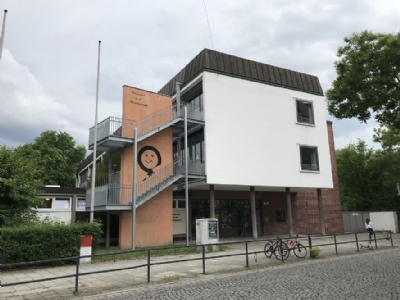Blutenburgstrasse 3
On November 8, 1923, Hitler attempted a coup in Bavaria, but it came to an end in the early morning of November 9 outside Feldherrnhalle in central Munich. During a brief shooting witht the Munich police, 16 coup participants were killed. Hitler was lightly injured and escaped and remained in hiding for two days before surrendering himself to the police. Hitler was charged with high treason and, along with eight other coup-participants, he was brought to justice on February 26, 1924.
The trial was held just outside central Munich in a former infantry school on Blutenburgstrasse 3, which belonged to the national defence. The trial lasted until April 1 and came to play Hitler and the Nazis in the hands. Judges of the court had sympathy for Hitler and allowed him to use the trial as a political platform for propaganda. Instead of denying the accusations of high treason, Hitler pleaded guilty on the grounds that he had attempted a coup out of true patriotism and that his purpose was to save Germany from the misery it found itself in.
The trial was also covered by the media and it received attention that extended far beyond Bavaria’s borders, even abroad, which favoured Hitler. From being a local agitator, through the trial, he became a national personality whose coup attempt won sympathies across the country. The verdict on Hitler was slight, some of the five judges even wanted to acquit Hitler, but in the end they agreed to sentence him to five years in prison at Landsberg Fortress outside Munich. Out of these five years he only had to serve a few months and was released at Christmas the same year.
Other participants put on trial was Heinz Pernet, sentenced to 15 months in prison. Friedrich Weber, 5 years in prison. Wilhelm Frick, 15 months in prison. Hermann Kriebel, 5 years in prison. Erich Ludendorff, acquitted. Wilhelm Brückner, 15 months in prison. Ernst Röhm, 15 months in prison. Robert Wagner, 18 months in prison. Like Hitler, they were all released prematurity.
Current status: Demolished (2018).
Address: Blutenburgstrasse 3, 806 36 München.
Get there: Metro to Stiglmaierplatz Station.
Follow up in books: King, David: The Trial of Adolf Hitler: The Beer Hall Putsch and the Rise of Nazi Germany (2017).

The infantry school is long gone but when it was demolished I do not know. In 2018 there is a primary school on the site. When the Nazis came to power in 1933, several places in Munich where the Nazis waged a struggle or suffered during the fighting years of the twenties became Nazi shrines with an almost quasi-religious status. One might think that the infantry school meets these requirements, but it did not. Most likely, this is because it was a success for Hitler. In the Nazi history description, the twenties were portrayed as years of struggle where the adversities and difficulties came into focus and then there was no room for success.